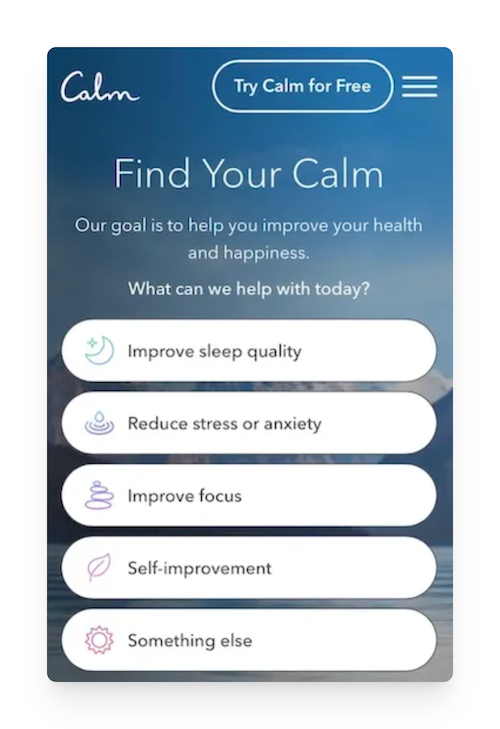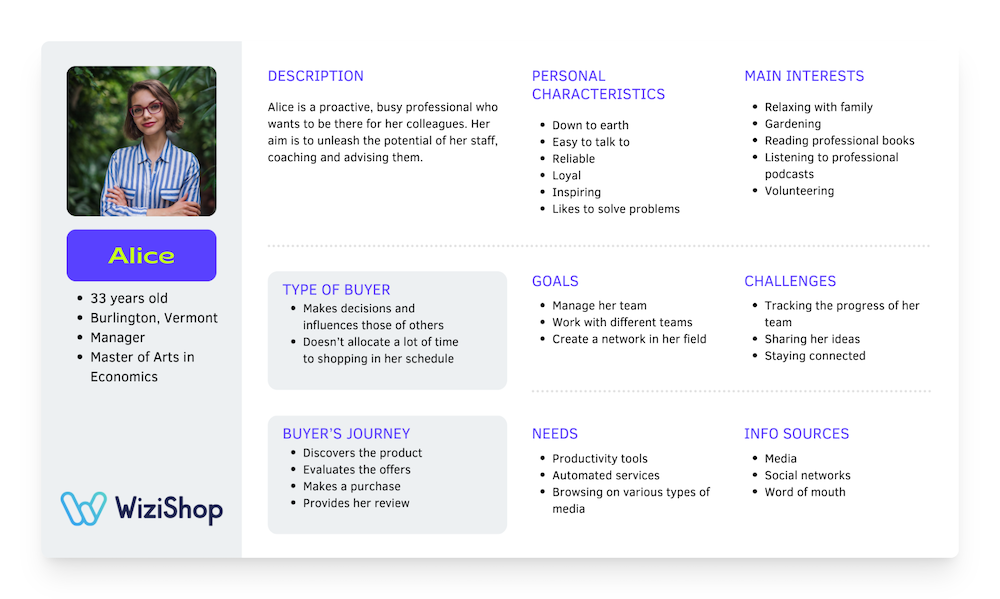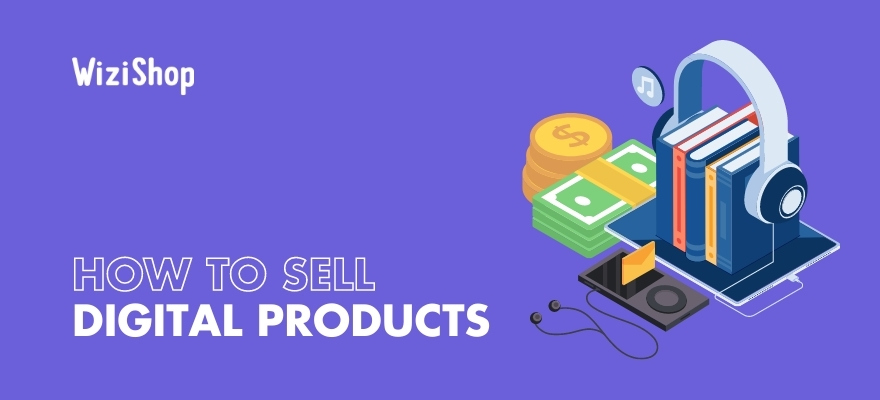Becoming an ecommerce entrepreneur can be an extremely rewarding experience, but if you’re hesitant about selling physical goods, you may want to consider another option…digital products!
These intangible assets can offer a number of benefits over tangible items for both the seller and the customer, making them an increasingly popular commodity when it comes to the world of online sales.
In this guide, we’ll go over everything you need to know to get started with selling digital products online today!
Table of contents
- 1. Brainstorm, brainstorm, brainstorm!
- 2. Perform market research
- 3. Establish how you can provide a solution to a problem
- 4. Decide on your niche and target audience
- 5. Confirm the validity of your idea
- 6. Make your digital products
- 7. Build your online store
- 8. Create a pre-launch buzz
- 9. Launch and market your digital products
1. Brainstorm, brainstorm, brainstorm!
You’ll want to start by first engaging in some brainstorming, either alone or with your team, and simply list any idea you have for a digital product to sell that comes to mind. At this stage, try not to overanalyze your ideas; the time for crossing things off your list will come later. Furthermore, you may be able to transform a less-than-stellar idea into a great one down the road!
If you’re feeling a bit stuck, consider asking yourself a few questions to help get the gears turning in your head:
- What experience, knowledge, or skills do you have today?
An easy way to begin is by identifying your current expertise and what you’re already good at doing. Although you’ll likely need to bolster your experience or knowledge or polish up on your skills at some point, already having a good foundation in a certain area is one of the best indicators as to what type of digital product you should sell online.
Say that you’re an expert watercolor artist. You might choose to make watercolor logo designs to sell or even teach a course on how to create watercolor art.
- What are you passionate about?
As with any ecommerce adventure, while it’s important that there’s demand for your products, it’s also advantageous for you to be interested in what you’re selling. This will help you to be more invested in your business, carry you through those moments of frustration, or when you’re managing the day-to-day, less exciting aspects of running an online store.
If you can talk about a specific topic for hours on end, for instance, there’s a good chance that you could design a course or build a community around the subject. Your passion will shine through the product that you create, which your customers will be sure to notice and appreciate!
- Is there a way to support your physical products with digital products (if you have an existing business)?
If you already have an ecommerce business, consider what digital items might be able to help shoppers use the tangible goods you sell more efficiently or get more enjoyment from their use. This can be an excellent way to boost sales for your physical and digital products alike!
Perhaps your online store sells camping equipment, for example. You could teach people differnt camping skills in a video training series, sharing techniques for beginner, intermediate, and advanced outdoor enthusiasts.
2. Perform market research
With your handy new list of ideas on hand, it’s time to venture online and see what the market looks like. This will help you to see what’s currently working for other businesses as well as what they could improve upon, which should give you inspiration for more ideas and allow you to further build your list.
There are numerous ways to go about researching the market, such as checking industry forums, Facebook groups, and blog posts. If you have an existing ecommerce business and are looking to support your physical goods with digital products, don’t hesitate to take a look at your product reviews and emails from customers to see what concerns they might have.
When it comes to selling digital items on the internet, there’s a wide range of products from which to choose. That being said, here are some of the basic categories of digital products that you’ll frequently find being sold online, noting that you can often combine two or more categories when deciding what to sell on your own online store.
Online courses
Today, people are exploring new paths to furthering their education. For this reason, educational products like online courses are some of the most popular intangible goods that you’ll find for sale on the internet. Whatever you wish to teach in your courses, it’s best that you’re passionate about the topic on which your online business idea is centered.
As this type of item can often be found for free, you might find that there’s already a plethora of content on your chosen subject matter that people can download at no cost. One of the best ways to get people to buy your product and justify the price is to emphasize how the product can help them change their lives rather than focus on the product itself.
For example, well-known yoga instructor Rachel Brathen, also known as Yoga Girl, offers a 7-part in-depth online course on her website, which is designed to not only help users learn yoga poses but healing practices and rituals to deepen their connection to themselves and to Mother Nature.

Licensed photos
Another way to enter the ecommerce universe via intangible goods is to sell licenses. With this strategy, you sell licenses to individuals and businesses, allowing them to use your creations in their own work.
This is the approach employed by, for example, photographers who sell the use of their images on stock photo sites. While working with an online marketplace to sell your licensed digital products takes a lot of the work off your hands, note that this type of selling channel will often charge a pretty hefty commission. For this reason, if you plan on creating and selling this kind of product regularly, launching your own online store is really your best bet.

Photos of mountains available on the Pexels stock photo site
Ebooks
Gone are the days when those aspiring to have their written works published had to chase after traditional publishing houses and compete with thousands of other submissions just to get their manuscripts read. Today, writers can go the ebook self-publishing route to get their books out into the world to their audience much more quickly!
An ebook is a digital book that can be read on devices like e-readers, tablets, or smartphones. The possibilities are endless when it comes to the types of ebooks you can write, including how-to guides, fiction novels, self-improvement books, recipe collections, or business strategy manuals.
Apps
Apps have skyrocketed in popularity as digital goods to sell in recent years because they provide value, scalability, and recurring revenue potential. Whether solving problems or entertaining users, apps can be monetized through one-time purchases, subscriptions, or in-app ads.
There's lots of room for creativity with this type of product, as you can create various types of apps: productivity tools, fitness trackers, educational apps, games, etc. Just remember to focus on user experience, conduct market research, and optimize for app store rankings.
Take inspiration from the Calm app, for example. The company states that this software, which aims to help users with sleep, meditation, and relaxation, has over 100 million downloads… A real success!

Memberships
Paid memberships or subscriptions for products or services such as coaching, courses, and groups are wonderful ways to generate recurring, often monthly, income. This strategy tends to work best when you’re thinking of regularly creating premium content to build an exclusive collection that only paid members can access.
You might even decide to pique potential customers’ interest by offering a free version of your digital product. If they like what they see, they may be encouraged to make the leap to becoming a paid subscriber. As far as setting the price for your membership goes, it can help to see what your competitors are offering for their products and services on the web.
In this example below, we find a membership offered by Juliette Crane, a painter whose works can be found in both private and public collections around the world. The School of Happy Painting Membership offers a monthly subscription featuring painting classes guided by Crane.

Art
Selling digital art can be a great way for artistically inclined entrepreneurs to make money, either in conjunction with selling physical pieces or going strictly digital. Artists can market various digital creations, including digital paintings, vector art, 3D models, and digital illustrations.
Note that if you opt to sell digital art files, engaging with your audience through social media platforms and offering high-quality previews can help bolster visibility and sales.
Because of the prevalence of piracy, it’s best to protect your creations, regardless of where you choose to sell them. This means, for example, adding watermarks to the photos you share of your work, as this will make it more difficult to use your images without your permission.
Tools and design templates
Another route ecommerce entrepreneurs often take when it comes to selling digital products is to sell tools or design templates that assist users with a specific task that can be rather time consuming to complete if they haven’t already mastered a certain skill.
For instance, you might opt to create things like mobile apps; video- or image-editing software filters, overlays, presets, and plugins; CV templates; or graphic design templates for brochures, flyers, social media posts, or websites.
Take the website Overleaf, for example. This company offers an extensive array of design templates that are easy to download. From résumé to newsletter design templates, there’s really something for everybody!

Music
Selling music as a digital product is a great way to monetize creativity while reaching a global audience. Since digital files have no inventory or shipping costs, artists can earn passive income through downloads, streaming, and licensing.
There are many ways to sell music digitally, including albums, singles, royalty-free tracks for content creators, sound effects, and beats for producers. To maximize music sales, choose the right platform, such as Bandcamp, Spotify, or SoundCloud. Bundling music with merch or memberships can also increase revenue.
3. Establish how you can provide a solution to a problem
After you’ve spent some time brainstorming, checking out what’s currently available on the market, and preparing your lengthy list of ideas, you’ll want to reflect on what problem(s) each of your ideas can help solve. However, keep in mind that not all problems are going to be equal in the eyes of consumers.
If your digital product is able to offer a solution to an issue that has a considerable negative impact on people’s lives, it’ll be much easier for you to promote your creation and get shoppers to buy it. Once you’ve identified the problems for which your ideas can provide solutions, it’s a good idea to rate the problems in terms of significance, later choosing the idea that solves one of the more pressing issues.
4. Decide on your niche and target audience
At this point, you should have several ideas for digital products to sell online that you’re pretty excited about. It’s now time to get more specific and select your niche and the customers you hope to attract with your product.
So, why is narrowing your target down advantageous? After all, wouldn’t trying to reach the largest group of customers possible be good to earn more sales?
In reality, choosing a more defined target will allow you to more easily build authority and demonstrate your expertise. What’s more, you’ll be able to create stronger, more compelling marketing messages, and you’ll have a better chance of prevailing over competing businesses.
To help you better organize your marketing strategy and appeal to your target audience, consider creating a buyer persona, displaying pertinent information for your ideal buyer with the help of tools like Canva or HubSpot.

5. Confirm the validity of your idea
You’ve likely already put in quite a bit of time and effort by this stage in trying to decide what digital product to sell online. Before going any further with your idea, though, no matter how great you believe it to be, you’ll want to verify its validity. There’s no sense in devoting any more of your resources to an idea until you know that it has a good chance of selling.
Fortunately, there are several ways that you can validate the digital product that you have in mind.
- Request feedback: Check in with your family and friends to get their thoughts on your product idea. You can also head to social media platforms or send an email to ask your target audience for their opinions. One of the easiest ways to get feedback from current and/or potential customers is via a poll or survey.
- Look at Google Trends: Compare a few different search queries related to your product idea to ensure that interest is at least constant and hopefully on the rise.
- Use keyword research tools: Investigate the number of consumers searching for the product or products that you’re considering to see where the most sales potential lies. Don’t forget to add the language and location filters so that you’ll get the most relevant results.
After you’ve determined that your idea is valid, you may want to create a smaller or basic version of your product to test it out with a group of people before you sell it to the masses. This will allow you to make any necessary improvements before your official launch and set your product up for the best chance of success.
6. Make your digital products
You’re now ready to start making the digital products that you plan to sell on the internet!
Even if you’ve already tested your idea with a small number of individuals, it can be beneficial to offer a simple version of your product at the start. This is because you may very well discover after your launch that your target audience’s actual needs and wants are different from what you’d originally expected. You can then adapt your product accordingly.
Regardless of what you decide to sell, be sure to test (and re-test) every aspect of anything you create before putting it on the market to ensure that you’re providing a product with the highest possible quality.
7. Build your online store
You can certainly opt to sell your digital products on online marketplaces or other platforms. However, the method that’s going to give you the most control of your business and greatest earning potential is to build your own online store, preferably with an outstanding ecommerce platform.
Good news: it’s now possible to sell digital products online with the best ecommerce solution around, Wizishop!
That’s right…whether you’re already using our platform to sell physical products or want to create a new ecommerce website, you now have the ability to go digital with your product line on the WiziShop platform.
No matter what you decide to sell, getting started is simple. Plus, the platform provides you with access to 400+ features, a helpful team of Business Coaches dedicated to supporting you on your ecommerce adventure with their complimentary coaching services, powerful artificial intelligence to generate a variety of text content for your website, loads of free training, 50+ optimizations to improve your store’s technical SEO, and much more.
WiziShop’s pricing plans start at $24.90/month, and you can even try the platform free for 7 days!
Try WiziShop free for 7 days
THE EASIEST NO-CODE ECOMMERCE SOLUTION✅ No credit card required
✅ Access to all features
✅ No commitment
8. Create a pre-launch buzz
Get a head start on getting the word out about the digital products you plan to sell by hyping up your creations before their official release!
You can use your presence on various social media platforms to begin building some hype around your creations, via product teasers, video demos, surveys, and/or contests. This can also be a good way to add more contacts to your email list, as your audience may very well be happy to provide their information in exchange for product updates.
In addition, you can even lock in early sales by making it possible for shoppers to pre-order your products, further piquing their interest by offering a special discount for your earliest customers!
9. Launch and market your digital products
The moment that your digital products are available online, your goal should be to boost awareness of your new releases, traffic to your online store, and sales. As you develop your marketing strategy, note that there are numerous methods that you can incorporate to achieve your unique objectives and make your first online sale, with the best options for you depending on your budget, expertise, and audience.
Create a lead magnet
Even if your products are relatively inexpensive, it can be helpful to offer a free version to generate interest, boost trust, and build your email list. While this approach isn’t feasible for every digital product, definitely consider implementing it if possible!
Optimize your presence on social media platforms
If you haven’t already created accounts for your business on social media, it’s time to do so. Today, social media marketing is pretty much essential for ecommerce success, and it’s highly likely that many (if not all) of your competitors will be multiple platforms. Furthermore, social media is an easy way to share content with your target market and build engagement with both your current and potential customers.
Collaborate with influencers
If your brand is pretty new, it can take a little while to build your presence on social media and awareness of your products…enter the power of influencers!
Influencers generally already have a significant following on one or more social platforms. With influencer marketing, you develop relationships with influencers related to your business activity, usually paying them a fee and/or providing them with a free product in exchange for their promotion of your business on social media.
When used strategically, this type of marketing can help awareness of your product and your brand skyrocket! Remember to do your homework when scoping out potential influencers you want to collaborate with, though, ensuring that they’re a good fit for your business and that their followers are real people rather than bots.
Work on your SEO
Taking the time to research keywords for your product descriptions, blog posts, and other aspects of your online store is crucial for the success of your business. Although optimizing your SEO won’t bring you instant results, it can do wonders for boosting your rankings on the results pages of search engines like Google in the long run.
Don’t forget that when you create your ecommerce website with WiziShop, we’ll take care of the technical aspects of your store’s SEO for you!
Take advantage of email marketing
Email marketing can be a really powerful strategy, as it allows you to nurture your relationship with your target audience, through carefully curated content sent via email on a consistent basis. As with any other kind of content marketing, the content you share in your email newsletters should provide a real benefit to your subscribers… It’s not just a place to promote your products.
To help build your email list, you can try adding a pop-up to your website, offering a discount code to current subscribers who refer new subscribers, making a landing page dedicated to your newsletter, and even creating a quiz for which participants must provide their contact details to see the results.
As you can see, selling digital products is a great way to enter the exciting world of ecommerce or to supplement the tangible goods that you already sell on your online store!
Although the methods for selling digital items may differ slightly from those for physical items, it still comes down to creating a high-quality product that serves to help consumers in one way or another. You’ll then need to spread the word about your digital product and build customer loyalty to aid in increasing downloads of your amazing creation.
Finally, you can’t be afraid to work on the constant improvement of your product and your services. If you find that your online store isn’t selling like you envisioned, revamping your product to meet the evolving wants and needs of your customers can only be good for your business!
FAQ
What is a digital product?
A digital product is simply a non-physical product that can be sold online. Because of its intangible nature, it can be sold over and over again, and you don’t need to worry about managing physical stock. Digital products are usually sent to customers as items that can be downloaded or streamed to listen to, watch, or read, with common formats being MP3s, PDFs, software, templates, and videos.
Although this type of product starts out as a digital item, it can be transformed into a physical commodity. For example, say that you’ve created a few exciting new ebooks to sell on your ecommerce website. The people purchasing your ebooks will receive them in a digital format, but they might then choose to print them out, resulting in tangible products that they can hold in their hands.
What are the advantages of selling digital products?
It’s no wonder why many ecommerce entrepreneurs opt to sell digital goods online, as there are several significant advantages that digital products offer over their physical counterparts. Here are just a few of the reasons why you might consider going the digital route when it comes to what you sell on your online store!
- Digital products are in high demand
Although digital products were popular with consumers before COVID-19 took the world by storm, their demand has only increased since then. For instance, with many people rethinking their career paths, they’ve turned to digital training and courses to either boost their current skills or learn something completely new.
In fact, according to Statista, the global online e-learning market is predicted to reach 400 billion U.S. dollars by 2026. Despite the improved pandemic situation in most parts of the world, plenty of workers are still looking to change careers, for financial reasons or otherwise.
- There’s lots of flexibility
You don’t have to limit yourself to selling just one type of digital product. Offering a variety of digital goods can actually be a great way to help your business grow!
For instance, you might opt to sell monthly paid subscriptions or licenses for access to your digital products, like art or music. You could also use your intangible creations as a way to boost your content marketing strategy, such as by providing new subscribers with a free ebook when they sign up for your email newsletter list.
- Customers have immediate access to their purchases
When people purchase physical goods on the internet, they usually have to wait at least a couple of days to receive their orders in the mail. Depending on how far the customer lives from the seller, this waiting period can even extend to several weeks. In most cases with digital products, however, customers can enjoy their purchases right away.
While shoppers will appreciate this instant access, it also benefits you as the business owner. Different from, say, if you start an online boutique to sell clothing, you don’t have to worry about orders getting lost during the shipping process, and you can look forward to receiving customer feedback on your products more quickly.
- You’ll save money
While selling physical products via an ecommerce website generally results in less overhead costs than selling with a brick-and-mortar store, there are still a few factors that can eat away at your bottom line. Supplies for product production, storage, and packaging/shipping are all costs that you’ll need to take into consideration.
In contrast, because digital goods don’t require you to use your financial resources for sourcing, storing, or shipping, you can allot more of your budget to other aspects of your business, such as marketing.
- It’s easy to scale your business
Venturing into the world of online sales is tempting for a variety of reasons, namely because there’s no limit to how much you can make in ecommerce!
Regardless of what you sell, if you’re getting ready to launch an ecommerce website, there’s a good chance that your goal is to grow your business over time. This can get tricky when you’re selling tangible items, especially if you’re handling everything on your own. For example, if you’re used to selling 5 products on average per day and this number suddenly jumps to 500, you may find it challenging to keep up.
However, you won’t have to deal with this issue with digital products, as even a significant unexpected increase in sales won’t have that much of an impact on the work required to deliver those orders to your customers. Keep in mind, though, that as you scale your business and product sales grow more regularly, you’ll likely need to expand your customer service team to manage more customer queries.
- You don’t need to worry about products being out of stock
When you choose to sell digital products online, inventory management gets a lot easier. There’s no limit to how often a single item can be sold, so running out of an in-demand digital product won’t be a concern.
While you’ll still want to keep track of how many times each item has been sold for other purposes, such as knowing which of your digital creations are your bestsellers, you won’t need to scramble to restock an item when it’s flying off the (virtual) shelves!
- Automation is easy to implement
Automation offers your ecommerce business a plethora of advantages, as it can help to increase efficiency, accuracy, and overall productivity. Implementing automation is super simple when it comes to selling digital goods.
For example, the shipping logistics associated with delivering physical products don’t come into play at all with digital items. It shouldn’t be too difficult to automate the delivery of your digital products once they’re purchased, making life easier for both you and your customer!
What are the challenges of selling digital products?
While there are plenty of benefits to selling digital products, as with anything in life, this path is not without its disadvantages. These are some of the challenges that you’ll want to consider before going this route with your ecommerce business.
- Competition is fierce
The ease of getting started with selling digital products makes it an appealing path to ecommerce entrepreneurs everywhere, meaning that you’re bound to come up against a fair bit of competition. What’s more, depending on what your online store offers, people may very well be able to find a similar version of your product for free on another platform.
This means that finding the right niche products for your business to sell is absolutely essential. In addition, it’s important to provide your audience with high-quality content and work on your brand image on social media and other platforms to help your business to stand out from the crowd and generate sales.
- Piracy is always a concern
With physical products you sell, it certainly can happen that a less-than-honest shopper might steal from your business by, for instance, claiming they never received their order in the mail when they in fact have been enjoying your product for days. This is usually a relatively rare problem, though, especially when you can follow the tracking of an order and see who signed for the package upon delivery.
It’s unfortunately a different story with digital products and services. Piracy is a major issue, as it’s not super complicated for people to steal and resell digital goods. You’ll therefore need to take care to protect the products you sell and your business with special measures, such as making it mandatory for customers to have a username and password to access your content.
- Consumers sometimes perceive these goods to have a lower value
Due to their non-physical format, digital products are often thought to be worth less money than physical goods, and many consumers may opt to try a free version instead.
It can be challenging to convince shoppers of a digital product’s worth, requiring a significant amount of time and effort to not only design and create the product, whether an ebook, course, software, or other content, but also to demonstrate it and convince potential customers in your audience to purchase the item.
What is the best type of digital product to sell?
The best digital products to sell are those that provide value to a specific audience while requiring minimal ongoing costs.
Ebooks are a great option because they offer passive income and can be sold on various platforms like Amazon Kindle or Gumroad. Courses are another profitable choice, allowing creators to share expertise and make money through platforms like Udemy or Teachable.
Digital templates for resumes, social media, or business documents are in high demand as they help buyers save time. Software, such as apps, plugins, or automation tools, is also a lucrative option, especially when sold via a subscription model.
Art in the form of digital illustrations, prints, or design assets sells well on sites like Etsy or Creative Market. Music, including beats, sound effects, and royalty-free tracks, can generate income through licensing and streaming.
Choosing the right sales platform and marketing effectively ensures success. What’s more, you can sell all of the aforementioned items on your own ecommerce site for maximum control and profits!
By understanding your audience and opting to create and sell high-quality digital products that best suit their needs, you can build a scalable and profitable business.










